外研版(2019)选择性必修 第四册Unit 3 The world meets China Using language—Listening课件(共42张PPT)
文档属性
| 名称 | 外研版(2019)选择性必修 第四册Unit 3 The world meets China Using language—Listening课件(共42张PPT) | 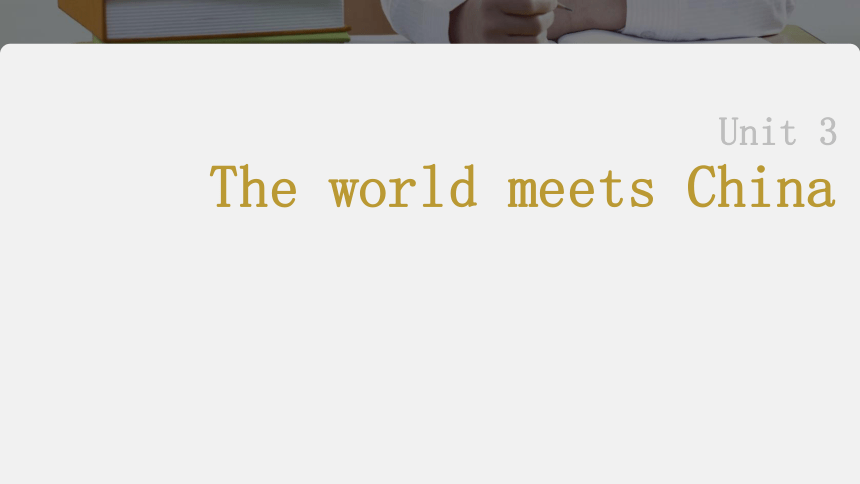 | |
| 格式 | pptx | ||
| 文件大小 | 37.7MB | ||
| 资源类型 | 教案 | ||
| 版本资源 | 外研版(2019) | ||
| 科目 | 英语 | ||
| 更新时间 | 2023-05-24 20:09:15 | ||
图片预览


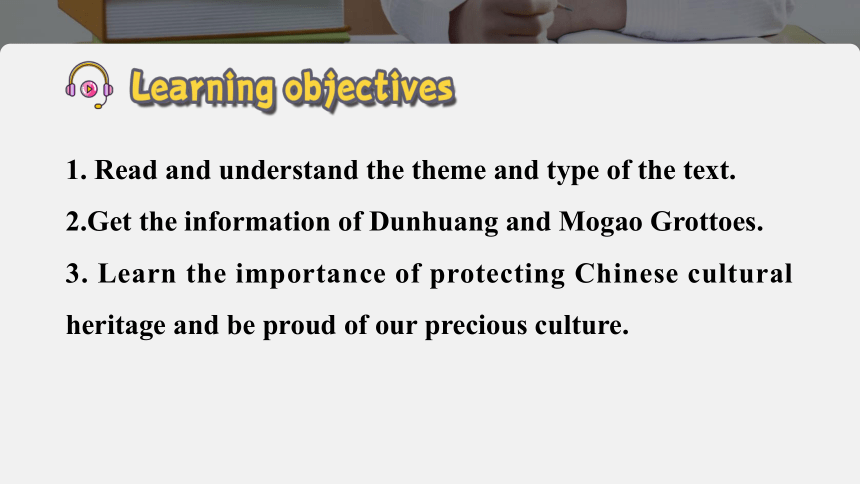
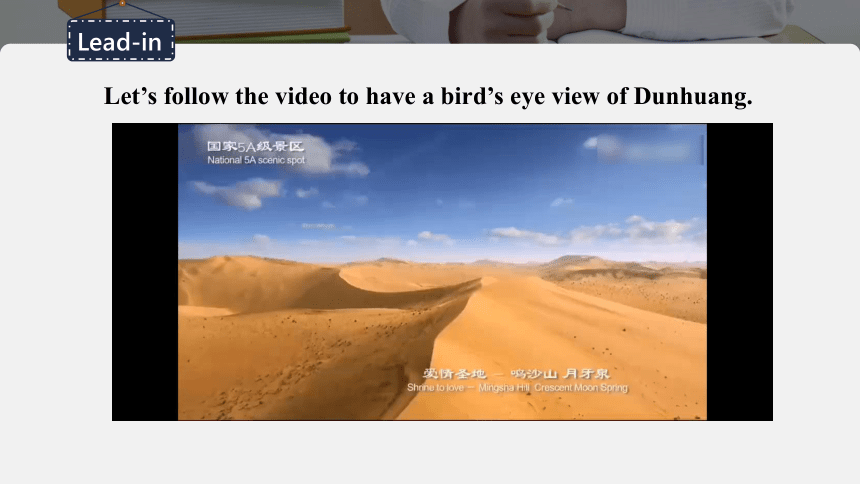
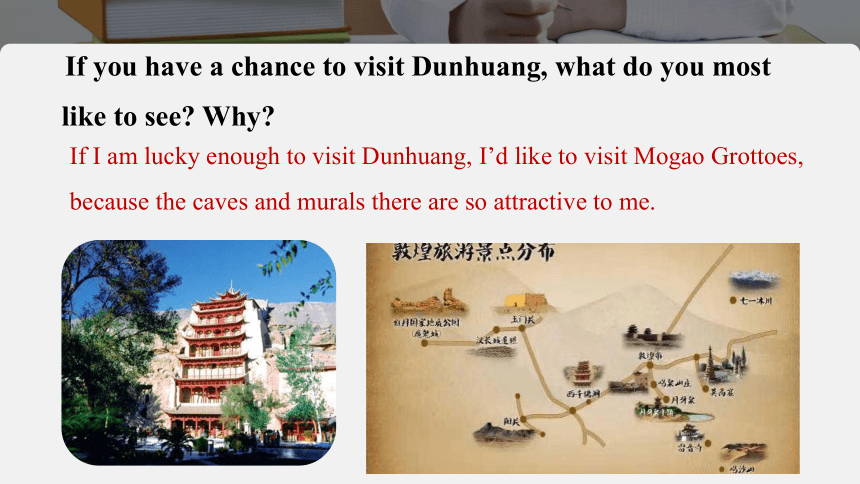
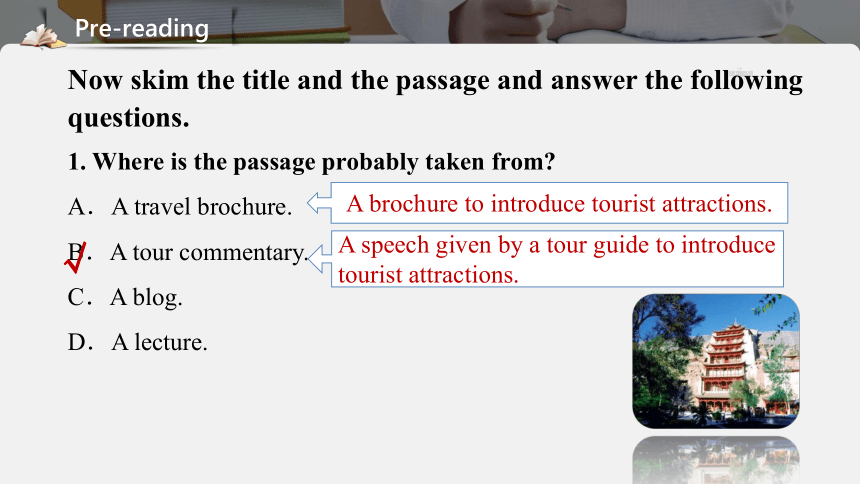
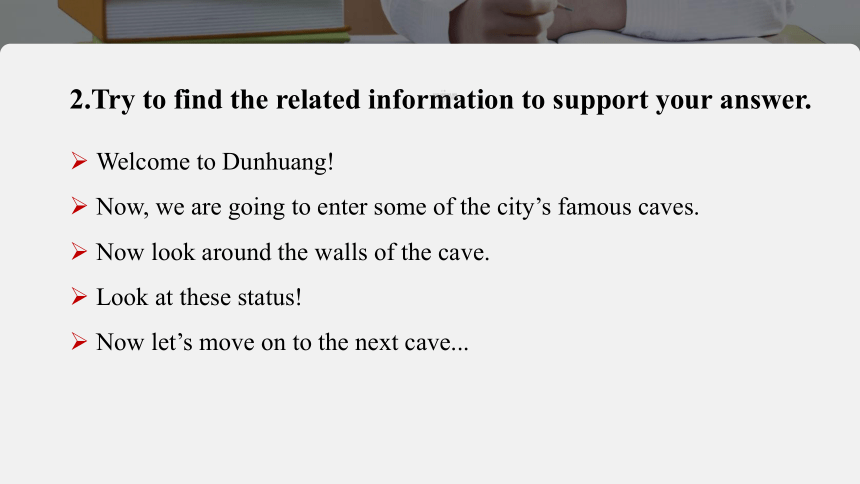
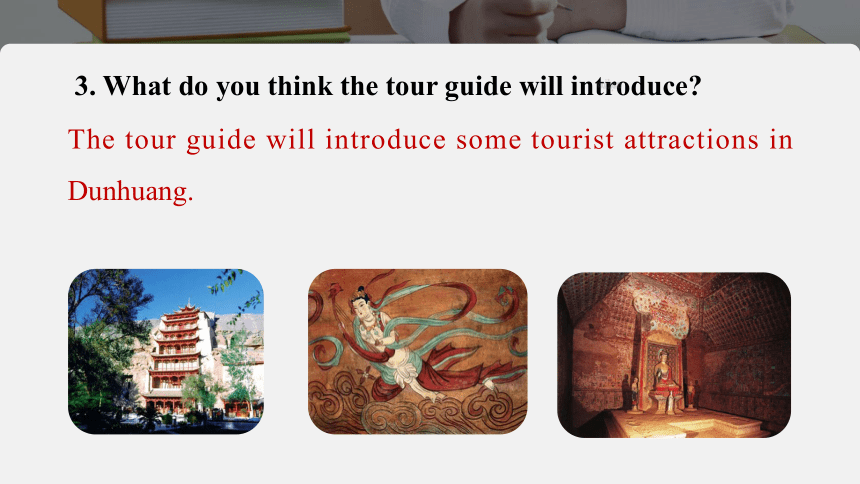
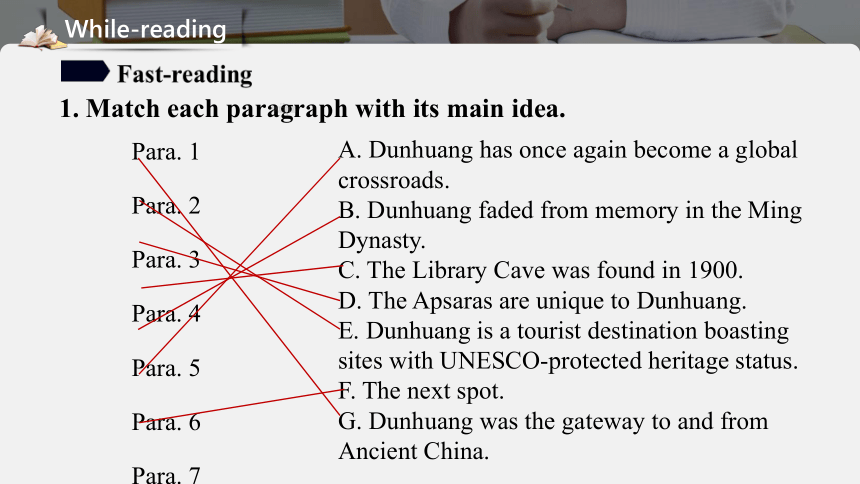

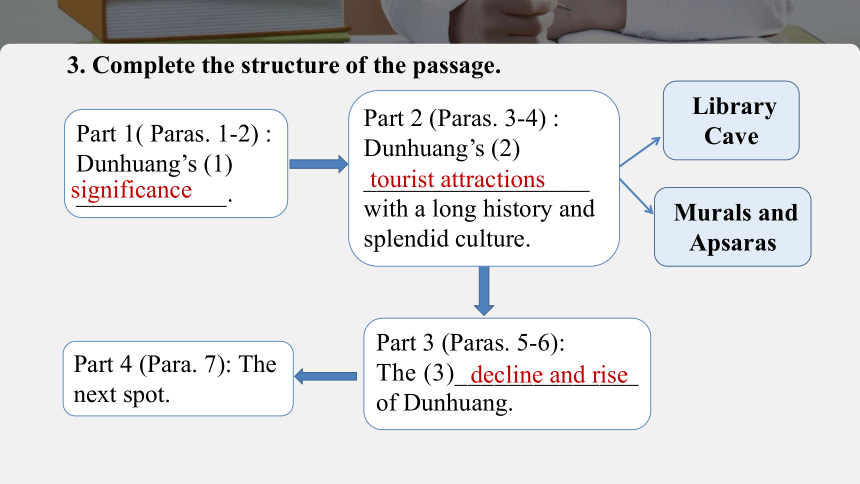

文档简介
(共42张PPT)
The world meets China
Unit 3
Using language—Listening
1. Read and understand the theme and type of the text.
2.Get the information of Dunhuang and Mogao Grottoes.
3. Learn the importance of protecting Chinese cultural heritage and be proud of our precious culture.
Lead-in
Let’s follow the video to have a bird’s eye view of Dunhuang.
If you have a chance to visit Dunhuang, what do you most
like to see Why
If I am lucky enough to visit Dunhuang, I’d like to visit Mogao Grottoes, because the caves and murals there are so attractive to me.
Pre-reading
1. Where is the passage probably taken from
A.A travel brochure.
B.A tour commentary.
C.A blog.
D.A lecture.
Now skim the title and the passage and answer the following
questions.
√
A brochure to introduce tourist attractions.
A speech given by a tour guide to introduce tourist attractions.
2.Try to find the related information to support your answer.
Welcome to Dunhuang!
Now, we are going to enter some of the city’s famous caves.
Now look around the walls of the cave.
Look at these status!
Now let’s move on to the next cave...
3. What do you think the tour guide will introduce
The tour guide will introduce some tourist attractions in Dunhuang.
Para. 1
Para. 2
Para. 3
Para. 4
Para. 5
Para. 6
Para. 7
A. Dunhuang has once again become a global crossroads.
B. Dunhuang faded from memory in the Ming Dynasty.
C. The Library Cave was found in 1900.
D. The Apsaras are unique to Dunhuang.
E. Dunhuang is a tourist destination boasting sites with UNESCO-protected heritage status.
F. The next spot.
G. Dunhuang was the gateway to and from Ancient China.
1. Match each paragraph with its main idea.
While-reading
2. What is the passage mainly about
A.Dunhuang’s glorious history.
B.The Mogao Grottoes.
C.The murals in the Mogao Grottoes.
D.An introduction to Dunhuang.
√
Murals and Apsaras
Library Cave
Part 3 (Paras. 5-6):
The (3)______________ of Dunhuang.
3. Complete the structure of the passage.
Part 1( Paras. 1-2) :
Dunhuang’s (1) ____________.
Part 2 (Paras. 3-4) : Dunhuang’s (2) __________________with a long history and splendid culture.
Part 4 (Para. 7): The next spot.
decline and rise
tourist attractions
significance
They might feel rather delighted and excited. Because it is rare to see a green land in the desert.
1. Can you imagine how the travellers felt when they saw the oasis of Dunhuang ahead of them Why
Careful-reading
Paragraphs 1-2
2. Find out the significance of Dunhuang.
(1)the gateway to and from Ancient China
(2)a centre of cultural and commercial exchange
(3)a world-class tourist destination boasting sites with UNESCO-protected heritage status
3. In what order does the tour guide introduce the Mogao Grottoes
4.What can you see in the Mogao Grottoes
look up—(1)____________________________
look around the walls of the cave—(2)________
paintings, other artworks, statues
murals
Now look around the walls of the cave.
Come a little bit closer so that you can get a better view.
The tour guide introduces the Mogao Grottoes in the order of _____.
space
(from the distant to near)
Now, we are going to enter some of the city’s famous caves, of which there are more than 700. Known as the Mogao Grottoes, these ancient caves were carved out of the rock over a period of 1,000 years. ...Look at them! The murals cover an astonishing area of 45,000 square metres.
5. What do the numbers in Paragraph 2 suggest
The numbers show the glorious and long history of Dunhuang.
Topic: (1)__________________________________________
___________________________
Highlight:(2)_______________________________
Reflection:(3)_________________________________during the Tang dynasty.
Various subjects of the murals(from religious stories
to scenes of everyday life)
The Apsaras/The “Flying Immortals”
The confidence and optimism of people
1. Organise the information and fill in the blanks.
2.What roles are shown in the Apsaras
The heavenly musicians, singers and dancers.
Paragraph 3
(1)sailing in the bright blue sky with their scarves flying
3.What kinds of Apsaras can you see in Dunhuang
(3)playing musical instruments
(2) holding lotuses
(4)dancing and throwing flowers
We can see Apasras (1)_____________,(2)________________,
(3)_____________________,(4)________________________.
4. What can we learn about the Apsaras
A.Their subjects are all about western stories.
B.They were used to decorate the top of caves.
C.They can only be seen in Dunhuang.
D.They were created in the Tang Dynasty.
√
1.Who has made a great contribution to finding the sealed cave
2.What were hidden in this sealed cave
Thousands of manuscripts, paintings, scrolls as well as silk embroideries.
A Taoist priest.
Paragraph 4
3. Paraphrase the sentence below.
We’ll have a chance to see some of them shortly—the Library Cave is only a stone’s throw from here.
4.What does the word “reveal” in the sentence “The scrolls also reveal how many...” in Paragraph 4 mean
A.To make sth. known to sb.
B.To make people understand.
C.To make people surprised.
D.To make people puzzled.
We’ll have an opportunity to see some of them soon—the Library Cave is not far from here.
√
We can picture that Dunhuang was once at the very centre of the Silk Road trade and different communities lived side-by-side within this great city.
5. What can we learn from these hidden treasures in the sealed cave
(3)______________
through China’s Belt and Roads Initiative
(2) ____ from memory
a global (4) _________
promote (6) ______________
strengthen (7)________
___________ between the countries along the Silk Road
(5)_____ place
Ming Dynasty
not as (1)________
as before
Today
The decline and rise of Dunhuang.
1. Finish the mind map below.
Dunhuang
prosperous
come back to life
fade
crossroads
ideal
cultural exchange
mutual
cooperation
Paragraphs 5-6
2.What’s your understanding of “Dunhuang has once again become a global crossroads”?
In the past, it was the center of cultural and commercial exchange on the old Silk Road. Today thanks to the Belt and Road Initiative, Dunhuang has once again become a center of exchange between China and European countries.
Suppose you are a tour guide, how will you introduce the next cave Please introduce the cave according to the following information.
Name:No. 96 cave(or nine-story building)
Time:the early Tang Dynasty
Highlight:The giant Buddha(35.5 meters high and 12 meters wide)
Now let’s move on to the next cave...
Paragraph 7
Now let’s move on to the next cave, No.96 cave. As we all know, Dunhuang Mogao Grottoes are a world treasure with varieties of caves, among which No.96 cave dating from the early Tang Dynasty is the most famous. Let’s come closer to have a clear view of it. In front of the cave is a nine-story building, for which people used to call it “nine-story building”. One of the highlights you can’t miss is the giant Buddha, the biggest Buddha, measuring 35.5 meters high and 12 meters wide. Standing here, you are sure to have a whole view of it.
Post-reading
1. Do you think Dunhuang is attractive to you Why?(Critical thinking)
Yes, of course. I think Dunhuang is so attractive to me that I can’t wait to pay a visit to it. Dunhuang is famous not only for its beautiful scenery but also for its importance of promoting cultural and commercial exchange.
Discussion
2. If your British friend Jim is interested in the Silk Road and Dunhuang, how will you introduce them to him?(Creative thinking)
The Silk Road is a historic trade road, which was used to transport silk, the fine and elegant goods, representing the civilization of Ancient China. This road has started from ancient capital of China—Chang’an (now Xi’an), a prosperous city at that time. Nowadays, there are many famous historic relics and sites along the Silk Road, among which Dunhuang is one of the most famous tourist attractions. Dunhuang was a place where west met east. Its long and glorious history represents its significance as a centre of cultural and commercial exchange.
Reflection
We should be proud of our precious cultural heritage and culture.
A nation stays alive when its culture stays alive.
A people without the knowledge of their past history, origin and culture is like a tree without roots.
Dunhuang was the gateway to and from Ancient China, a place 1.______ East met West, and a green island in the middle of the desert.
Dunhuang served as a centre of 2._______(culture) and commercial exchange. Today, Dunhuang is a world-class tourist destination boasting sites with UNESCO-protected heritage status. It has more than 700 caves. 3._______(know) as the Mogao Grottoes, these ancient caves 4.____________(carve) out of the rock over a period of 1,000 years. There you can see paintings and other artworks.
where
cultural
Known
were carved
Summary
Look at these statues! You can see 5.________(element) from Ancient Greece, India and Iran. The murals cover an 6. __________(astonish) area of 45,000 square metres.
The subjects of the Dunhuang murals vary from religious stories to scenes of everyday life. But one type of mural that is unique to Dunhuang shows the Apsaras, or “Flying Immortals”.The painting of Apsaras during the Tang Dynasty reflects the 7.___________ (confident) and optimism of people from that time.
elements
astonishing
confidence
In 8.____ sealed cave, now known as the famous Library Cave, were hidden thousands of manuscripts, paintings and scrolls, as well as silk embroideries. We’ll have a chance to see some of 9._____(they) shortly. However, the reason why the Library Cave was sealed up all those years ago remains a mystery.
This century is bringing the Silk Road 10.___ life once more through the Belt and Road Initiative. Dunhuang has once again become a global crossroads.
the
them
to
Welcome to Dunhuang! On the old Silk Road, this city was the gateway to and from Ancient China, a place where East met West, and a green island in the middle of the desert. You can only imagine how travellers felt when they saw the oasis of Dunhuang ahead of them.
定语从句
宾语从句
时间状语从句
Analyze the key points of the text
Paragraph 1
Dunhuang’s long and glorious history represents its significance as a centre of cultural and commercial exchange. Today, Dunhuang is a world-class tourist destination boasting sites with UNESCO-protected heritage status. Now, we are going to enter some of the city’s famous caves, of which there are more than 700. Known as the Mogao Grottoes, these ancient caves were carved out of the rock over a period of 1,000 years.
定语从句
过去分词短语作状语
现在分词短语作后置定语,修饰a world-class tourist destination
Paragraph 2
If you look up, you can see the paintings and other artworks that are testimony to how the Silk Road brought East and West together. Look at these statues! You can see elements from Ancient Greece, India and Iran. Now look around the walls of the e a little bit closer
so that you can get a better view. Look at them! The murals cover an astonishing area of 45,000 square metres.
条件状语从句
目的状语从句
宾语从句
定语从句,修饰先行词the paintings and other artworks
Paragraph 2
The subjects of the Dunhuang murals vary from religious stories to scenes of everyday life. But one type of mural that is unique to Dunhuang shows the Apsaras, or “Flying Immortals”. Representations of these heavenly musicians, singers and dancers decorate the walls of many caves. Take a look at this mural. The Apsaras are depicted sailing in the bright blue sky, with their scarves flying, as if they are about to fly down to meet us.
方式状语从句
“with+宾语+现在分词”复合结构
vary from...to...由······到······不等
定语从句
Paragraph 3
And here is another one. Move over here where you can see it in more detail. The Apsaras are holding lotuses, playing musical instruments, dancing and throwing flowers. The painting of Apsaras reached a peak during the Tang Dynasty; these images are full of life, reflecting the confidence and optimism of people from that time.
地点状语从句
现在分词短语作状语
Paragraph 3
Now, something really extraordinary happened in 1900, when a Taoist priest made one of the most important finds of the 20th century. In a sealed cave, now known as the famous Library Cave, were hidden thousands of manuscripts, paintings and scrolls, as well as silk embroideries. We’ll have a chance to see some of them shortly—the Library Cave is only a stone’s throw from here. Dating from 405 AD to 1002 AD, these hidden treasures give us a picture of Dunhuang when it was at the very centre of the Silk Road trade.
时间状语从句
过去分词短语作定语
现在分词短语作状语
时间状语从句
Paragraph 4
Thanks to this ancient library, we now know that goods arrived in Dunhuang from as far away as North-east Europe, and that goods were also exported from Dunhuang across Asia and Europe. The scrolls are so detailed that they describe the vast range of goods that were imported and exported from Dunhuang, such as ceramics, medicine, perfumes and fruit, to name just a few. The scrolls also reveal how many different communities lived side-by-side within this great city. However, the reason why the Library Cave was sealed up all those years ago remains a mystery.
两个并列的宾语从句
so...that...引导结果状语从句
定语从句,修饰the vast range of goods
定语从句
仅举几例
多亏了
Paragraph 4
In the Ming Dynasty, trade routes changed and Dunhuang was not as prosperous as it used to be. Gradually, it faded from memory,
even though it was once such a great city.
让步状语从句
比较状语从句
Paragraph 5
This century is bringing the Silk Road to life once more through the Belt and Road Initiative. Dunhuang has once again become a global crossroads since it hosted hundreds of representatives from over 51 countries for the Silk Road International Cultural Expo in 2017. Given that the theme of the Expo was to promote cultural exchange and strengthen mutual cooperation between the countries along the Silk Road, Dunhuang was the ideal place.
Now, let’s move on to the next cave…
时间状语从句
Paragraph 6
原因状语从句
Homework
Preview language points and recite the key points of the text.
本课结束
The world meets China
Unit 3
Using language—Listening
1. Read and understand the theme and type of the text.
2.Get the information of Dunhuang and Mogao Grottoes.
3. Learn the importance of protecting Chinese cultural heritage and be proud of our precious culture.
Lead-in
Let’s follow the video to have a bird’s eye view of Dunhuang.
If you have a chance to visit Dunhuang, what do you most
like to see Why
If I am lucky enough to visit Dunhuang, I’d like to visit Mogao Grottoes, because the caves and murals there are so attractive to me.
Pre-reading
1. Where is the passage probably taken from
A.A travel brochure.
B.A tour commentary.
C.A blog.
D.A lecture.
Now skim the title and the passage and answer the following
questions.
√
A brochure to introduce tourist attractions.
A speech given by a tour guide to introduce tourist attractions.
2.Try to find the related information to support your answer.
Welcome to Dunhuang!
Now, we are going to enter some of the city’s famous caves.
Now look around the walls of the cave.
Look at these status!
Now let’s move on to the next cave...
3. What do you think the tour guide will introduce
The tour guide will introduce some tourist attractions in Dunhuang.
Para. 1
Para. 2
Para. 3
Para. 4
Para. 5
Para. 6
Para. 7
A. Dunhuang has once again become a global crossroads.
B. Dunhuang faded from memory in the Ming Dynasty.
C. The Library Cave was found in 1900.
D. The Apsaras are unique to Dunhuang.
E. Dunhuang is a tourist destination boasting sites with UNESCO-protected heritage status.
F. The next spot.
G. Dunhuang was the gateway to and from Ancient China.
1. Match each paragraph with its main idea.
While-reading
2. What is the passage mainly about
A.Dunhuang’s glorious history.
B.The Mogao Grottoes.
C.The murals in the Mogao Grottoes.
D.An introduction to Dunhuang.
√
Murals and Apsaras
Library Cave
Part 3 (Paras. 5-6):
The (3)______________ of Dunhuang.
3. Complete the structure of the passage.
Part 1( Paras. 1-2) :
Dunhuang’s (1) ____________.
Part 2 (Paras. 3-4) : Dunhuang’s (2) __________________with a long history and splendid culture.
Part 4 (Para. 7): The next spot.
decline and rise
tourist attractions
significance
They might feel rather delighted and excited. Because it is rare to see a green land in the desert.
1. Can you imagine how the travellers felt when they saw the oasis of Dunhuang ahead of them Why
Careful-reading
Paragraphs 1-2
2. Find out the significance of Dunhuang.
(1)the gateway to and from Ancient China
(2)a centre of cultural and commercial exchange
(3)a world-class tourist destination boasting sites with UNESCO-protected heritage status
3. In what order does the tour guide introduce the Mogao Grottoes
4.What can you see in the Mogao Grottoes
look up—(1)____________________________
look around the walls of the cave—(2)________
paintings, other artworks, statues
murals
Now look around the walls of the cave.
Come a little bit closer so that you can get a better view.
The tour guide introduces the Mogao Grottoes in the order of _____.
space
(from the distant to near)
Now, we are going to enter some of the city’s famous caves, of which there are more than 700. Known as the Mogao Grottoes, these ancient caves were carved out of the rock over a period of 1,000 years. ...Look at them! The murals cover an astonishing area of 45,000 square metres.
5. What do the numbers in Paragraph 2 suggest
The numbers show the glorious and long history of Dunhuang.
Topic: (1)__________________________________________
___________________________
Highlight:(2)_______________________________
Reflection:(3)_________________________________during the Tang dynasty.
Various subjects of the murals(from religious stories
to scenes of everyday life)
The Apsaras/The “Flying Immortals”
The confidence and optimism of people
1. Organise the information and fill in the blanks.
2.What roles are shown in the Apsaras
The heavenly musicians, singers and dancers.
Paragraph 3
(1)sailing in the bright blue sky with their scarves flying
3.What kinds of Apsaras can you see in Dunhuang
(3)playing musical instruments
(2) holding lotuses
(4)dancing and throwing flowers
We can see Apasras (1)_____________,(2)________________,
(3)_____________________,(4)________________________.
4. What can we learn about the Apsaras
A.Their subjects are all about western stories.
B.They were used to decorate the top of caves.
C.They can only be seen in Dunhuang.
D.They were created in the Tang Dynasty.
√
1.Who has made a great contribution to finding the sealed cave
2.What were hidden in this sealed cave
Thousands of manuscripts, paintings, scrolls as well as silk embroideries.
A Taoist priest.
Paragraph 4
3. Paraphrase the sentence below.
We’ll have a chance to see some of them shortly—the Library Cave is only a stone’s throw from here.
4.What does the word “reveal” in the sentence “The scrolls also reveal how many...” in Paragraph 4 mean
A.To make sth. known to sb.
B.To make people understand.
C.To make people surprised.
D.To make people puzzled.
We’ll have an opportunity to see some of them soon—the Library Cave is not far from here.
√
We can picture that Dunhuang was once at the very centre of the Silk Road trade and different communities lived side-by-side within this great city.
5. What can we learn from these hidden treasures in the sealed cave
(3)______________
through China’s Belt and Roads Initiative
(2) ____ from memory
a global (4) _________
promote (6) ______________
strengthen (7)________
___________ between the countries along the Silk Road
(5)_____ place
Ming Dynasty
not as (1)________
as before
Today
The decline and rise of Dunhuang.
1. Finish the mind map below.
Dunhuang
prosperous
come back to life
fade
crossroads
ideal
cultural exchange
mutual
cooperation
Paragraphs 5-6
2.What’s your understanding of “Dunhuang has once again become a global crossroads”?
In the past, it was the center of cultural and commercial exchange on the old Silk Road. Today thanks to the Belt and Road Initiative, Dunhuang has once again become a center of exchange between China and European countries.
Suppose you are a tour guide, how will you introduce the next cave Please introduce the cave according to the following information.
Name:No. 96 cave(or nine-story building)
Time:the early Tang Dynasty
Highlight:The giant Buddha(35.5 meters high and 12 meters wide)
Now let’s move on to the next cave...
Paragraph 7
Now let’s move on to the next cave, No.96 cave. As we all know, Dunhuang Mogao Grottoes are a world treasure with varieties of caves, among which No.96 cave dating from the early Tang Dynasty is the most famous. Let’s come closer to have a clear view of it. In front of the cave is a nine-story building, for which people used to call it “nine-story building”. One of the highlights you can’t miss is the giant Buddha, the biggest Buddha, measuring 35.5 meters high and 12 meters wide. Standing here, you are sure to have a whole view of it.
Post-reading
1. Do you think Dunhuang is attractive to you Why?(Critical thinking)
Yes, of course. I think Dunhuang is so attractive to me that I can’t wait to pay a visit to it. Dunhuang is famous not only for its beautiful scenery but also for its importance of promoting cultural and commercial exchange.
Discussion
2. If your British friend Jim is interested in the Silk Road and Dunhuang, how will you introduce them to him?(Creative thinking)
The Silk Road is a historic trade road, which was used to transport silk, the fine and elegant goods, representing the civilization of Ancient China. This road has started from ancient capital of China—Chang’an (now Xi’an), a prosperous city at that time. Nowadays, there are many famous historic relics and sites along the Silk Road, among which Dunhuang is one of the most famous tourist attractions. Dunhuang was a place where west met east. Its long and glorious history represents its significance as a centre of cultural and commercial exchange.
Reflection
We should be proud of our precious cultural heritage and culture.
A nation stays alive when its culture stays alive.
A people without the knowledge of their past history, origin and culture is like a tree without roots.
Dunhuang was the gateway to and from Ancient China, a place 1.______ East met West, and a green island in the middle of the desert.
Dunhuang served as a centre of 2._______(culture) and commercial exchange. Today, Dunhuang is a world-class tourist destination boasting sites with UNESCO-protected heritage status. It has more than 700 caves. 3._______(know) as the Mogao Grottoes, these ancient caves 4.____________(carve) out of the rock over a period of 1,000 years. There you can see paintings and other artworks.
where
cultural
Known
were carved
Summary
Look at these statues! You can see 5.________(element) from Ancient Greece, India and Iran. The murals cover an 6. __________(astonish) area of 45,000 square metres.
The subjects of the Dunhuang murals vary from religious stories to scenes of everyday life. But one type of mural that is unique to Dunhuang shows the Apsaras, or “Flying Immortals”.The painting of Apsaras during the Tang Dynasty reflects the 7.___________ (confident) and optimism of people from that time.
elements
astonishing
confidence
In 8.____ sealed cave, now known as the famous Library Cave, were hidden thousands of manuscripts, paintings and scrolls, as well as silk embroideries. We’ll have a chance to see some of 9._____(they) shortly. However, the reason why the Library Cave was sealed up all those years ago remains a mystery.
This century is bringing the Silk Road 10.___ life once more through the Belt and Road Initiative. Dunhuang has once again become a global crossroads.
the
them
to
Welcome to Dunhuang! On the old Silk Road, this city was the gateway to and from Ancient China, a place where East met West, and a green island in the middle of the desert. You can only imagine how travellers felt when they saw the oasis of Dunhuang ahead of them.
定语从句
宾语从句
时间状语从句
Analyze the key points of the text
Paragraph 1
Dunhuang’s long and glorious history represents its significance as a centre of cultural and commercial exchange. Today, Dunhuang is a world-class tourist destination boasting sites with UNESCO-protected heritage status. Now, we are going to enter some of the city’s famous caves, of which there are more than 700. Known as the Mogao Grottoes, these ancient caves were carved out of the rock over a period of 1,000 years.
定语从句
过去分词短语作状语
现在分词短语作后置定语,修饰a world-class tourist destination
Paragraph 2
If you look up, you can see the paintings and other artworks that are testimony to how the Silk Road brought East and West together. Look at these statues! You can see elements from Ancient Greece, India and Iran. Now look around the walls of the e a little bit closer
so that you can get a better view. Look at them! The murals cover an astonishing area of 45,000 square metres.
条件状语从句
目的状语从句
宾语从句
定语从句,修饰先行词the paintings and other artworks
Paragraph 2
The subjects of the Dunhuang murals vary from religious stories to scenes of everyday life. But one type of mural that is unique to Dunhuang shows the Apsaras, or “Flying Immortals”. Representations of these heavenly musicians, singers and dancers decorate the walls of many caves. Take a look at this mural. The Apsaras are depicted sailing in the bright blue sky, with their scarves flying, as if they are about to fly down to meet us.
方式状语从句
“with+宾语+现在分词”复合结构
vary from...to...由······到······不等
定语从句
Paragraph 3
And here is another one. Move over here where you can see it in more detail. The Apsaras are holding lotuses, playing musical instruments, dancing and throwing flowers. The painting of Apsaras reached a peak during the Tang Dynasty; these images are full of life, reflecting the confidence and optimism of people from that time.
地点状语从句
现在分词短语作状语
Paragraph 3
Now, something really extraordinary happened in 1900, when a Taoist priest made one of the most important finds of the 20th century. In a sealed cave, now known as the famous Library Cave, were hidden thousands of manuscripts, paintings and scrolls, as well as silk embroideries. We’ll have a chance to see some of them shortly—the Library Cave is only a stone’s throw from here. Dating from 405 AD to 1002 AD, these hidden treasures give us a picture of Dunhuang when it was at the very centre of the Silk Road trade.
时间状语从句
过去分词短语作定语
现在分词短语作状语
时间状语从句
Paragraph 4
Thanks to this ancient library, we now know that goods arrived in Dunhuang from as far away as North-east Europe, and that goods were also exported from Dunhuang across Asia and Europe. The scrolls are so detailed that they describe the vast range of goods that were imported and exported from Dunhuang, such as ceramics, medicine, perfumes and fruit, to name just a few. The scrolls also reveal how many different communities lived side-by-side within this great city. However, the reason why the Library Cave was sealed up all those years ago remains a mystery.
两个并列的宾语从句
so...that...引导结果状语从句
定语从句,修饰the vast range of goods
定语从句
仅举几例
多亏了
Paragraph 4
In the Ming Dynasty, trade routes changed and Dunhuang was not as prosperous as it used to be. Gradually, it faded from memory,
even though it was once such a great city.
让步状语从句
比较状语从句
Paragraph 5
This century is bringing the Silk Road to life once more through the Belt and Road Initiative. Dunhuang has once again become a global crossroads since it hosted hundreds of representatives from over 51 countries for the Silk Road International Cultural Expo in 2017. Given that the theme of the Expo was to promote cultural exchange and strengthen mutual cooperation between the countries along the Silk Road, Dunhuang was the ideal place.
Now, let’s move on to the next cave…
时间状语从句
Paragraph 6
原因状语从句
Homework
Preview language points and recite the key points of the text.
本课结束
